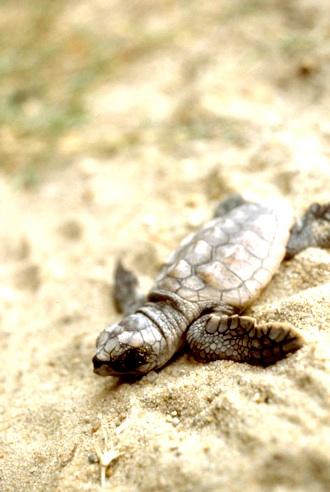Even sea turtles need a hand from time to time. At Biscayne National Park, the work of students and park staff resulted in mixed results from turtles that came ashore in the park to lay eggs this year.
The turtle conservation efforts began early in the year with nesting beach habitat restoration events throughout January and March through the Alternative Winter Break and Alternative Spring Break programs. More than 80 students representing colleges from throughout the nation assisted park staff in removing large amounts of debris from sea turtle nesting beaches on Elliott Key, according to the park.
Students spent long days removing assorted debris from nesting beaches since that debris, if not removed, presents a serious hindrance to nesting sea turtles and can often lead to aborted nesting attempts (false crawls), the park notes.
"Items removed from the beaches included assorted plastics, glass bottles, derelict fishing and boating gear, and larger wooden items such as shipping pallets and boards. Biscayne National Park extends an extra special thanks to all of the hard-working students who dedicated their college breaks to restoring nesting beach habitats within the park!" said park officials.
Loggerhead, Green, and Hawksbill turtles are all commonly observed in Biscayne National Park waters. Leatherback turtles may also be observed, but this species is uncommon in the park, according to the park.
Here's a breakdown on this year's nesting activity at Biscayne:
Since mid-May, five nesting beaches have been faithfully monitored by a core group of park staff and volunteers. Late June brought some stormy weather which interfered with field monitoring work on some days. Weather permitting, staff and volunteers have monitored the beaches each day to look for signs of new turtle nesting activity. Activity is classified as: 1) nest, 2) false crawl, or 3) undetermined. A false crawl occurs when a female comes ashore but fails to produce a nest, perhaps due to obstructive vegetation, presence of people or predators, or poor habitat quality. An event is classified as “undetermined” when it seems possible, but not certain, that a nest has been produced.
June 15
Nest 1
The smaller mesh covering was removed on July 31 and the nest was examined for hatching success on August 14. Unfortunately, this nest was not very successful. Only 6 of the 128 eggs in the nest had hatched; all other eggs failed to develop.
June 16
False Crawl 1
Vegetation and/or debris resulted in the turtle abandoning her attempts at laying the nest
June 18
Nest 2
It was difficult to tell if this was indeed a nest, so a protective screen was laid down on the crawl area to prevent predation, in the event that eggs were, in fact, deposited. Upon close examination on August 11th, it was revealed that this was indeed a nest, and 93 of the 97 eggs in this nest hatched. This was a very successful nest!
June 29
False Crawl 2
Thick vegetation appeared to be the cause for this failed nesting attempt
July 1
Nest 3
This nest was discovered by chance, as it was located in an area that is not routinely monitored. Unfortunately, the nest was fully predated by raccoons, with 42 broken egg shells remaining as evidence. The nest itself was very shallow and therefore probably gave easy access to the raccoon predators.
July 21
False Crawl 3
This false crawl occurred approximately 15 feet from Nest 1, and it is unclear why this crawl did not result in a nest.
July 22
Nest 4
Once the turtle reached the shore, she apparently walked parallel to shore for a bit before finding the perfect nesting place. As a result, her tracks were easily spotted, making the nest readily identifiable. Sadly, when this nest was assessed after the 60-day incubation period, it was discovered that the seasonally high tides had flooded the nest and 55 of the 56 eggs in the nest were only partially developed and failed to hatch. One broken eggshell was found, suggesting that possibly one sea turtle hatchling made it safely to the sea.
September 3
False Crawl 4
The sea turtle left tracks up the beach but may have been deterred by the presence of large woody debris in her path.
September 17
False Crawl 5
The sea turtle made noticeable attempts to dig a nest cavity, however the area she selected was very rocky and not suitable for nesting.
September 25
Nest 5
This late-season nest was found among mats of seagrass and algae that had been carried ashore by the high tides




Add comment